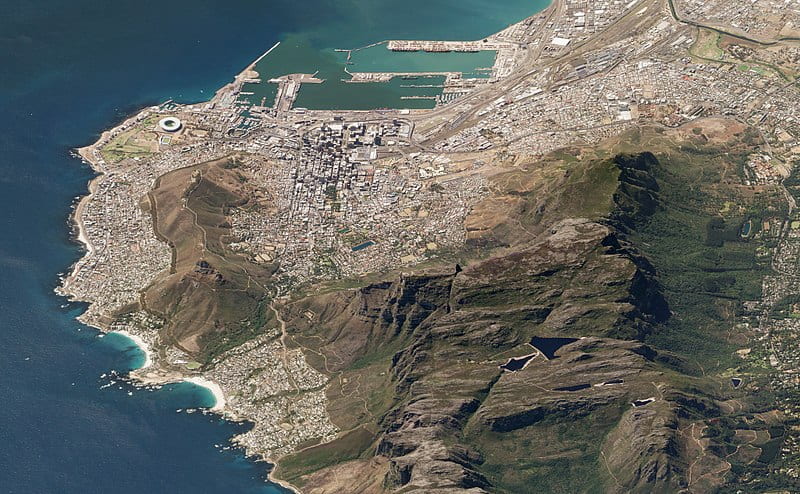When a crisis hits, it is crucial to shine a light upon the various factors that led to the issue, exacerbated its impacts, and hindered its resolution. An insightful example of this is the Cape Town water crisis in South Africa, which received a lot of media attention in 2017 and 2018. The crisis was so pressing at the time, it was anticipated that Cape Town would run their water reservoirs completely dry.

SkySat satellite image of Cape Town (Source: Planet Labs)
Reflecting on the event reveals that a combination of factors contributed to the forecasting of ‘Day Zero’ (i.e. the name given to the day Cape Town would run of out of water). The two most significant influences were environmental and political in nature. In conjunction, these two factors are to blame for the severity of the water insecurity that loomed over Capetonians. In retrospect, the situation forced local governments to implement major changes in order to mitigate the issue.
Water scarcity is a problem that millions face globally. What makes this case particularly unique is the fact that Cape Town is a large, industrialized city that does not lack access to fresh water reservoirs, while many rural, water-scarce communities do. Obviously, this does not imply that the city’s water reservoirs are incapable of depletion. In fact, there is plenty of historical evidence to suggest that Cape Town has struggled with its municipal water services for centuries. Attempts to control water demand have been reported in Cape Town as early as 1655, and unprecedented action to control water supply was taken in 1850. In modern times, this crisis demonstrates that Cape Town’s water woes continue to persist.
Environmental Factors
Changes in the natural environment played a significant role in the Cape Town water crisis. For years, scientists have shown that anthropogenic climate change continues to worsen. Over time, climate change has led to temporal alterations in Cape Town’s wet and dry seasons, as well as reductions in precipitation intensities and average increases in temperature. The change in seasonal precipitation patterns, reduced rainfall, and elevated evaporation rates (as a result of temperature increases) proved to be a deadly combination. In fact, it is estimated that global warming made the drought five times more likely to occur.
Furthermore, population growth places added pressure on water supplies, as it directly correlates with water demand. Cape Town’s relatively stagnant infrastructure development failed to keep up with the increasing demand, fostering conditions which reduced the reliability and resiliency of the water supply system. Between the overburdening pressures of climate change and population growth, natural factors clearly weighed too heavily on the risks for water scarcity.
Political Factors
Aside from natural influences, politics played a prominent role in heightening the severity of the drought. Government actors and public authorities held the most influence in regard to solving the Cape Town water crisis. Relations between local and national political stakeholders were complicated due to the fact that Western Cape, where Cape Town is located, was (and still is) the only province ruled by the official opposition party (the Democratic Alliance party, DA).
The distribution of water in Cape Town is controlled by the national government, federally ruled by the African National Congress (ANC) party. This jurisdictional division of power proved to be detrimental because the national government initially failed to respond to the calls for help from Capetonians. The failure of national-level actors to support their provincial counterparts can be largely attributed to inadequate finances, poor management, and negligence within the system. The federal government’s over-allocation of water to agriculture and its initial refusal to acknowledge the severity of the crisis demonstrate that political interests were seemingly at odds with one another.
In response to criticism of the city’s lack of action towards drought relief, Mayor Patricia de Lille lost her authority in managing the water crisis in January of 2018. To overcome the political conflict of interest between the national and provincial governments, Mmusi Maimane—Leader of the DA and of the Opposition in the National Assembly of South Africa—was put in charge of the drought response task team. However, this shift in control was criticized by city and state officials, who deemed it an inappropriate role for a political party leader and an infringement on the boundaries delineating governmental separation of powers. Evidently, the political conflict has had drastic implications on Cape Town, epitomized by the heightened (and potentially avoidable) severity of the city’s water crisis.
Another wave of criticism arose in response to a proposed drought levy. This mitigation strategy came under heavy scrutiny as it was deemed inequitable by affluent citizens and large landholders. The levy strategy was, in essence, an attempt to raise approximately one billion Rand each year for four years, for drought relief. This resulted in controversy because the levy was based on property value, rather than water consumption. Thus, those who made an effort to lower their water consumption, or installed water-saving technologies, were unduly penalised. The non-governmental Organisation Undoing Tax Abuse (OUTA) questioned the legality of the new policy and published a list of alternative measures to address the crisis.
The growing gap between the rich and the poor was highlighted and politicized as a result of the Cape Town drought. While the affluent complained about the water tax and negotiated other economic disincentives to water consumption, the poor were confronted with a serious problem. Among Cape Town’s population of 4 million, about 1 million live in informal settlements with an already scarce supply of water. Why should a quarter of the population, who consume only 4.5% of the entire city’s water supply, face restrictions on their water consumption as a result of over-usage by the wealthier and more profligate upper three-quarters of the population? Heavy water restrictions ultimately intensified their pre-existing water insecurity.
Conclusion
The evidence presented here suggests the government significantly influenced how the Cape Town drought unfolded. Evidently, the national government and administration must learn from their mistakes, cooperate better with their provincial counterparts in the future, and avoid mitigation strategies that impose injustices. Unfortunately, the political conflicts that heightened the severity of the drought contributed to weakening public trust in the government. This suggests that: a) conflict of interest arising from the federalist separation of powers needs to be discussed, and b) authority figures guided by political self-interest are not necessarily the best fit authority to handle every situation—natural disasters being a prime example. In the future, involving stakeholders like civil society organisations (e.g. OUTA), or intergovernmental bodies (e.g. the United Nations) may prove to be a constructive approach that should be considered. Without a direct stake in regional and national politics, the stakeholders could help governments better understand the consequences and implications of their actions. Lastly, involving civil society and third parties to help with intragovernmental cooperation in the future suggests the need for the dilution of political control and power centres in and across South Africa. However, this is an outcome that only citizens of South Africa can foster effectively by making their voices heard.

Lindsay Katz is a fourth year Bachelor of Arts and Science student, specializing in international development and mathematical science. She is interested in the application of statistical analysis in the context of global issues, specifically pertaining to poverty and inequality. Lindsay is planning to pursue a Master’s of Data Science in the coming year, and is passionate about using her skills in mathematics to make a positive difference in the world.

